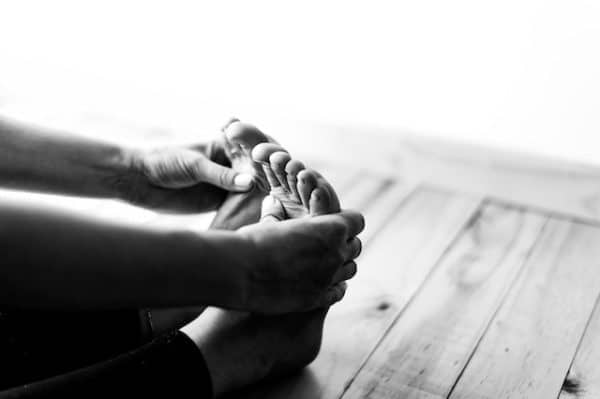Do you experience pain in your feet? If so, you’re not alone. Foot pain is a common problem and can range from mild to severe. There are many potential causes of foot pain, including structural problems such as bunions or hammertoes, nerve entrapment syndromes like tarsal tunnel syndrome, overuse injuries like plantar fasciitis, and arthritis. In this article, we’ll take a look at some of the most common reasons for foot pain and how they can be treated.
Structural Problems:
Structural problems are the most common causes of foot pain, including bunions, hammertoes, and Morton’s neuroma.
- Bunions are bony bumps that form at the base of the big toe on the outside of the foot due to misalignment of the joint.
- Hammertoes are a condition where one or more toes become bent out of shape due to tightness in their surrounding tendons or ligaments.
- Morton’s neuroma is a swollen nerve between two toes caused by compression from wearing shoes that are too tight or too rigid.
Structural problems can cause joint instability, limited range of motion, deformity, and painful symptoms such as burning and stabbing pain in the feet while walking.
Treatment options vary depending on the underlying cause but can include custom orthotics, physical therapy, stretches and exercises, corticosteroid injections, or even surgery in extreme cases.
Nerve Entrapment Syndromes:
Nerve entrapment syndromes are conditions in which a nerve in the foot is pinched or compressed, causing pain or numbness in the affected area.
These syndromes can include:
- Tarsal tunnel syndrome occurs when the posterior tibial nerve is compressed as it passes through a narrow opening in the ankle.
- Morton’s neuroma was mentioned previously.
- Plantar fibular nerve entrapment is a condition characterized by pain on the outside of the foot due to compression of the sciatic nerve at its point of exit from the calf muscle.
Treatment for these conditions may involve stretching and strengthening exercises, physical therapy to relieve pressure on the nerves, custom orthotics to improve structural alignment, or even surgery if necessary. However, it’s important to note that while surgical intervention can be effective in some cases, it often isn’t necessary, and other treatments should be tried first.
Overuse Injuries:
Overuse injuries can also be a cause of foot pain. These include plantar fasciitis, Achilles tendinitis, and stress fractures.
- Plantar fasciitis is an inflammation of the plantar fascia, a thick band of tissue that connects your heel to the front of your foot. It is caused by excessive strain on the fascia due to running or walking with poor form or wearing inadequate shoes.
- Achilles tendinitis occurs when the Achilles tendon becomes inflamed due to overuse or repetitive activities such as running and jumping.
- Stress fractures are tiny cracks in the bone that can occur when too much pressure is placed on the feet with activities like running or jumping.
Symptoms of these overuse injuries include pain in the heel or arch area, swelling, redness, and tenderness to touch.
Treatment usually consists of rest and stretching exercises to allow the injury time to heal properly. For more severe cases, physical therapy may be required in order to strengthen the muscles around the injury and ensure proper recovery. Healthy Steps provide orthotic devices such as custom insoles can also be beneficial for reducing pressure on certain areas of the feet and providing additional support during healing.
Arthritis:
Arthritis is a condition that affects the joints, causing inflammation and pain. Several types of arthritis can affect the feet, including rheumatoid arthritis, osteoarthritis, gout, and pseudogout.
- Rheumatoid arthritis is an autoimmune disorder in which the body’s immune system attacks its own tissues, leading to joint swelling and pain.
- Osteoarthritis is a degenerative joint disease caused by wear and tear on the joints over time due to aging or injury.
- Gout is caused by high levels of uric acid in the blood, which form crystals around the joints, causing intense pain and inflammation.
- Pseudogout occurs when calcium crystals form around the joints instead of uric acid crystals.
Symptoms of arthritis in the feet can include stiffness, swelling, redness, difficulty walking or bearing weight on the affected area(s), and a grating sensation when moving the joint.
Treatment for foot arthritis typically involves lifestyle changes such as losing weight if necessary, avoiding high-impact activities like running or jumping that may exacerbate symptoms, wearing supportive shoes with good arch support and cushioning to reduce stress on painful joints, taking anti-inflammatory medications or corticosteroids to reduce inflammation and pain, and physical therapy.
Diabetes:
One of the most common complications of diabetes is foot pain. This is because diabetes can cause damage to the nerves and blood vessels in the feet, leading to a condition known as diabetic neuropathy.
Symptoms of diabetic neuropathy in the feet can include a burning or tingling sensation, numbness, and pain. In severe cases, it can lead to the loss of sensation in the feet, which can increase the risk of injury and infection. People with diabetes also have a higher risk of developing foot ulcers and amputations.
Foot pain caused by diabetes can also be caused by peripheral artery disease (PAD). PAD is a condition in which the blood vessels in the feet become narrowed or blocked, reducing blood flow to the feet. This can cause pain, cramping, and weakness in the feet, especially during physical activity.
To prevent foot pain caused by diabetes, it’s important to manage your blood sugar levels through diet, exercise, and medication. Regularly monitoring blood sugar levels can help prevent nerve damage and poor blood flow to the feet. It’s also important to take good care of your feet by keeping them clean and dry, checking them regularly for cuts, blisters, or other signs of injury, and wearing comfortable shoes that fit well.
If you are experiencing foot pain caused by diabetes, it’s important to seek medical attention right away. Your doctor or a podiatrist can help you manage your symptoms and prevent further complications.
Foot pain can be caused by various conditions, ranging from mild overuse injuries to more severe conditions like arthritis. It’s important to consult a doctor if you experience any recurrent or severe foot pain, as they will be able to provide an accurate diagnosis and recommend treatments that are best suited for your condition. Treatment options may include lifestyle modifications, physical therapy, custom orthotics, medications, and in some cases, surgery.





